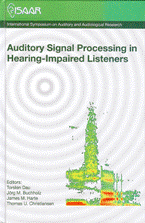Word recognition performance in competing sentence and multitalker babble paradigms in listeners with hearing loss
Abstract
The word-recognition performances of 24 listeners with normal hearing and of 72 listeners with hearing loss were evaluated using a single-talker competing message (CM) and a six-talker multitalker babble (MTB). The 50% points were calculated using the Spearman-Kärber equation. The mean 50% point with the CM paradigm was -3.5 dB signal-to-noise ratio (S/N) and was 3.9 dB S/N with the MTB for the listeners with normal hearing. The listeners with hearing loss had a mean 50% point of 11.1 dB S/N with the CM and 13.4 dB S/N with the MTB. For both groups of listeners, the slopes of the psychometric functions were steeper for the MTB paradigms than for the CM material paradigms. These findings suggest that the listeners with hearing loss perform similarly with both noises, whereas the listeners with normal hearing probably achieve a partial release from masking from the valleys in the amplitude modulations of the CM more so than the modulations provided by the MTB.
References
Bacon, S. P, Opie, J. M., and Montoya, D. Y. (1998). "The effects of hearing loss and noise masking on the masking release for speech in temporally complex back- grounds," J. Speech. Lang. Hear. Res., 41, 549-563.
Department of Veterans Affairs. (2004). "Speech recognition and identification materials. Disc 4.0," Mountain Home, (TN): VA Medical Center.
Dirks, D. D., Wilson, R. H., and Bower, D. (1969). "Effects of pulsed noise on selected speech materials," J. Acoust. Soc. Am., 46, 898-906.
Finney, D. J. (1952). "Statistical method in biological assay," London, C. Griffen. Fletcher, H. and Steinberg, J. C. (1929). "Articulation testing methods," Bell System Technical J., 8, 806-854.
Holma, T., Laitakari, K., Sorri, M., and Winblad, I. (1997). "New speech-in-noise test in different types of hearing impairment," Acta. Otolaryng. Suppl., 529, 71-73.
Miller, G. A. and Licklider, J. C. R. (1950). "The intelligibility of interrupted speech," J. Acoust. Soc. Am., 22, 167-173.
Tillman, T. W, and Carhart, R. (1966). "An expanded test for speech discrimination utilizing CNC monosyllabic words. Northwestern University Auditory Test No. 6," Brooks Air Force Base, TX USAF School of Aerospace Medicine Technical Report.
Wilson R. H. (2003). "Development of a speech in multitalker babble paradigm to assess word-recognition performance," J. Am. Acad. Audiol., 14, 453-470.
Wilson, R. H., Abrams, H. B., and Pillion, A. L. (2003). "A word-recognition task in multitalker babble using a descending presentation mode from 24-dB S/B to 0-dB S/B," J. Rehabil. Res. Dev., 40, 321-328.
Wilson, R. H., and Burks, C. A. (2005). "The Use of 35 words to evaluate gearing loss in terms of signal-to-babble ratio: A clinic protocol," J. Rehabil. Res. Dev., 42, 839-852.
Wilson, R. H., and Carhart, R. (1969). "Influence of pulsed masking on the threshold for spondees. J. Acoust. Soc. Am., 46, 998-1010.
Wilson, R. H., Carnell, C. S., and Cleghorn, A. L. (2007). "The Words-in-Noise (WIN) test with multitalker babble and speech-spectrum noise maskers," J. Acad. Am. Audiol., 18, 522-530.
Wilson, R. H., Zizz, C. A., Shanks, J. E., and Causey, G. D. (1990). "Normative data in quiet, broadband noise, and competing message for Northwestern University Audi- tory Test No. 6 by a female speaker," J. Speech. Hear. Disord., 55, 771-778.
Additional Files
Published
How to Cite
Issue
Section
License
Authors who publish with this journal agree to the following terms:
a. Authors retain copyright* and grant the journal right of first publication with the work simultaneously licensed under a Creative Commons Attribution License that allows others to share the work with an acknowledgement of the work's authorship and initial publication in this journal.
b. Authors are able to enter into separate, additional contractual arrangements for the non-exclusive distribution of the journal's published version of the work (e.g., post it to an institutional repository or publish it in a book), with an acknowledgement of its initial publication in this journal.
c. Authors are permitted and encouraged to post their work online (e.g., in institutional repositories or on their website) prior to and during the submission process, as it can lead to productive exchanges, as well as earlier and greater citation of published work (See The Effect of Open Access).
*From the 2017 issue onward. The Danavox Jubilee Foundation owns the copyright of all articles published in the 1969-2015 issues. However, authors are still allowed to share the work with an acknowledgement of the work's authorship and initial publication in this journal.


